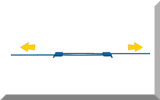The Two Leader Knots You Need to Know
|
 Stage 1 |
First, double back the end of the single strand wire leader and thread the mono through the eye produced. |
 Stage 2 |
Next, start whipping back the mono over itself and the leader. |
 Stage 3 |
Then, make about ten turns before tucking the tag end of the mono through the loop such that it emerges on the same side as it entered. |
 Stage 4 |
Finally, lubricate with saliva before smoothly pulling the knot up tight. Trim both ends, and that's it - a knot for connecting different line types and diameters |
Connecting Lines of Similar Types and Diameters
For example:~
- connecting a low-visibility fluorocarbon leader to a more visible nylon monofilament main line, or
- connecting a heavier nylon monofilament shock leader to a lighter mono main line
Two Uni-Knots tied Back-to-Back
 Stage 1 |
First, lay the two lines to be connected alongside and form a loop as shown here. |
 Stage 2 |
Now make at least four turns (more for light lines) around both strands and through the loop. Wet the knot with saliva and start tightening it by first pulling on the tag end in the direction of the arrow. |
 Stage 3 |
Then, with the knot now well consolidated, snip the ends off close and pull on the two lines to slide the two knots towards each other. |
 Stage 4 |
And that's it, the finished knot for joining a nylon monofilament main line to a fluorocarbon leader. |









